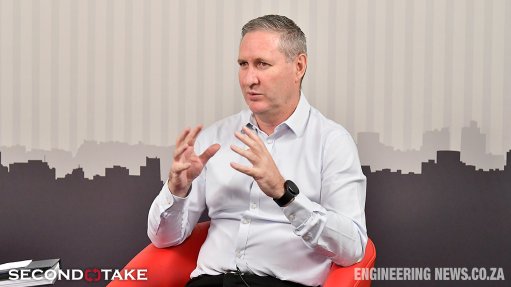Project to save mall about R2m over three years
Maponya Mall, a shopping complex in Soweto, will achieve energy reduction savings of 81% after completing the replacement of its fluorescent lighting with light-emitting diode (LED) technology this month and will save about R2-million over a three-year period.
The Maponya Mall project was initiated in November 2012 by property development company Zenprop and electrical company Standard Electrical. Lighting manufacturer LED Lighting South Africa was contracted to replace 1 059 units of double 58 W fluorescent lights with LED lights, LED Lighting South Africa project management head Deon Kotze tells Engineering News.
LED lights only consume 22 W a fitting, while fluorescent lights consume 122 W a fitting, he adds.
The mall’s original fluorescent lighting was cheap and fairly efficient in producing light, but it was not good for the environment, he points out.
“Our challenge was to ensure that the LED lighting not only improved efficiency and ‘burn hours’, which comprise good life expectancy and maintenance-free operations, but also achieved improved lighting.”
The LED product provides better lighting, as it is more directional than fluorescent lighting. “Fluorescent lighting emits light at a 360º angle, causing most of it to reflect into the back of the bulkhead (cove), with a small portion emitted across the ceiling,” Kotze explains.
LED light sources, however, emit light in a single direction across the ceiling, with no light emitted back into the cove. LEDs, therefore, save two-thirds of the energy used by fluorescent tubes.
Kotze points out that, while LED lighting is more expensive than fluorescent lights, the savings achieved over the long term are significant.
He further notes that, besides replacing inefficient lighting, savings can be achieved by study- ing a building’s use of electricity to identify wastage in terms of power factor correction, voltage peak optimisation, peak load assess- ments and tariff correction, states LED Light- ing South Africa CEO Pierre van Helden.
Proper certification and approved contractors are needed to install LED units and all the specifications were adhered to during the implementation of the Maponya Mall project, he says.
Van Helden adds that the company is in the process of completing similar projects, which involve the V&A Waterfront, Two Oceans Aquarium and Cavendish Square shopping mall, in Cape Town, that also aim to reap the benefits of LED technology and save with State-owned power utility Eskom’s rebate programme, as Maponya Mall has done.
Eskom approved the Maponya Mall project for a rebate qualification at the end of 2012 and has many rebate incentive programmes. “Following programme requirements and using the correct LED technology provides a roadmap for success,” Van Helden points out.
Eskom’s rebate programme offers to cover about 85% of the total cost of replacing a business’s conventional lighting with selected LED products.
The utility has established aggressive goals and targets to support customers in their drive towards achieving optimised energy consumption. In acknowledging that reducing energy demand within industry may require investments in newer technologies, equipment and processes, Eskom’s integrated demand management programme makes funds available to its clients in support of reduced energy demand or consumption.
The rebate model is structured to provide consumers with an incentive for converting their inefficient technologies to energy-saving solutions, provided that the suppliers of the efficient lighting are registered with the programme.
“Eskom has set standards for lighting companies wishing to introduce their products onto the market,” Van Helden notes, adding that the Maponya Mall project has set a standard for the greening of South Africa’s malls that others should follow.
“South African companies have seen the need to become greener and save energy, ultimately saving our natural coal resources and becoming more carbon neutral.
“It is not just about selling lighting solutions, but about selling lighting that offers energy savings and reduces the strain on the national grid,” he concludes.
Comments
Press Office
Announcements
What's On
Subscribe to improve your user experience...
Option 1 (equivalent of R125 a month):
Receive a weekly copy of Creamer Media's Engineering News & Mining Weekly magazine
(print copy for those in South Africa and e-magazine for those outside of South Africa)
Receive daily email newsletters
Access to full search results
Access archive of magazine back copies
Access to Projects in Progress
Access to ONE Research Report of your choice in PDF format
Option 2 (equivalent of R375 a month):
All benefits from Option 1
PLUS
Access to Creamer Media's Research Channel Africa for ALL Research Reports, in PDF format, on various industrial and mining sectors
including Electricity; Water; Energy Transition; Hydrogen; Roads, Rail and Ports; Coal; Gold; Platinum; Battery Metals; etc.
Already a subscriber?
Forgotten your password?
Receive weekly copy of Creamer Media's Engineering News & Mining Weekly magazine (print copy for those in South Africa and e-magazine for those outside of South Africa)
➕
Recieve daily email newsletters
➕
Access to full search results
➕
Access archive of magazine back copies
➕
Access to Projects in Progress
➕
Access to ONE Research Report of your choice in PDF format
RESEARCH CHANNEL AFRICA
R4500 (equivalent of R375 a month)
SUBSCRIBEAll benefits from Option 1
➕
Access to Creamer Media's Research Channel Africa for ALL Research Reports on various industrial and mining sectors, in PDF format, including on:
Electricity
➕
Water
➕
Energy Transition
➕
Hydrogen
➕
Roads, Rail and Ports
➕
Coal
➕
Gold
➕
Platinum
➕
Battery Metals
➕
etc.
Receive all benefits from Option 1 or Option 2 delivered to numerous people at your company
➕
Multiple User names and Passwords for simultaneous log-ins
➕
Intranet integration access to all in your organisation


















